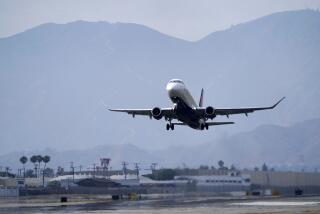Small Airports’ Big Question: Do Costly Towers Buy Safety?
- Share via
There is little doubt that Tuesday’s fiery collision of two planes on the runway of a small Midwestern airport will fuel concerns about the absence of control towers on many airfields nationwide.
The crash occurred at Baldwin Municipal Airport, near Quincy, Ill., about 5 p.m. It was cloudy and nearly dark, but there was at least 10 miles of visibility. A United Express turboprop, arriving from Burlington, Iowa, had just landed, according to witnesses, when it collided with what is presumed to have been a small King Aire 200 taxiing for takeoff on the same runway.
All 12 people aboard the United Express and the two on the smaller plane were killed as both aircraft exploded in flames. The unanswered questions, at this point, are why the pilots failed to spot each other visually and why one or both were not warned of the danger by required radio communications.
Baldwin is an “uncontrolled” airport in Federal Aviation Administration lingo, and that is where the control tower issue takes center stage. Such airports don’t have operating towers manned either by FAA officials or officials contracted by the FAA. So pilots on landings and takeoffs must depend on seeing other aircraft and on radio contact with planes in the area, to the point of continually broadcasting their location and proximity to an airfield.
Control tower personnel would add an important additional layer of safety and surveillance. Nationally, however, says the FAA’s Seattle office, there are 18,224 airfields, including a multitude of rural strips. Of the total, about 5,415 are sponsored or run by a local government, and 667 of the government-related airports serve air carrier operations, involving craft ranging from jumbo jets to small commuter planes. But just 447 of the government-connected airports have control towers.
The debate brings to mind the Nov. 14 fatal crash involving a small cargo plane at Van Nuys Airport, though there are differences. That crash occurred in the early morning hours of a very foggy night, at a time when the Van Nuys tower is closed because there is so little traffic. The Quincy crash occurred in early evening, during aviation rush hour, when an operating tower might have provided help.
This is not a problem in much of Southern California. The Santa Monica, Hawthorne, Lancaster, Van Nuys, Fullerton, El Monte, Costa Mesa and Camarillo airports all have control towers, but not all the towers are open 24 hours a day. Other airports and airfields, such as Santa Paula and Double Eagle II, have no tower.
Flight experts say that there is nothing inherently unsafe about uncontrolled airports, but they do place much more responsibility on the pilots flying into and out of them. That leads to another question: Shouldn’t the FAA take a comprehensive look at its uncontrolled airports that conduct air carrier operations, like the one at Quincy, and think again about whether more of these fields should have admittedly expensive control towers?
The Air Line Pilots Assn. has repeatedly called for control towers at all airports served by air carriers. Baldwin Municipal would fit that category.
Much remains to be learned about the cause of the Illinois tragedy, but the need for more control towers should be high on any list of possible air safety improvements.
More to Read
Sign up for Essential California
The most important California stories and recommendations in your inbox every morning.
You may occasionally receive promotional content from the Los Angeles Times.













